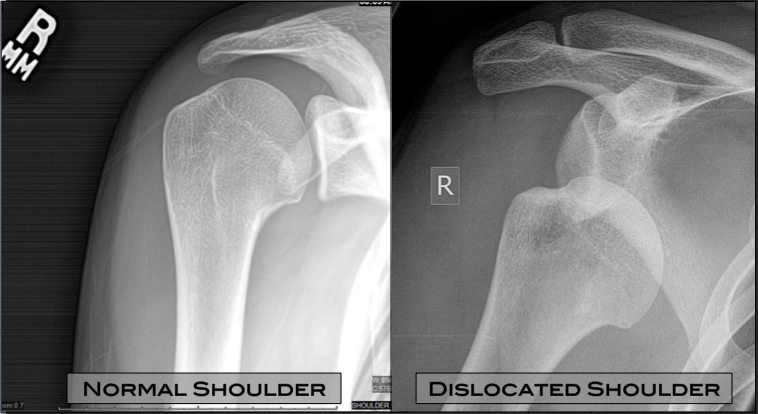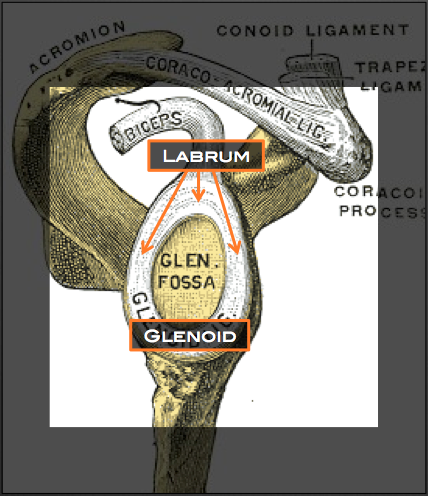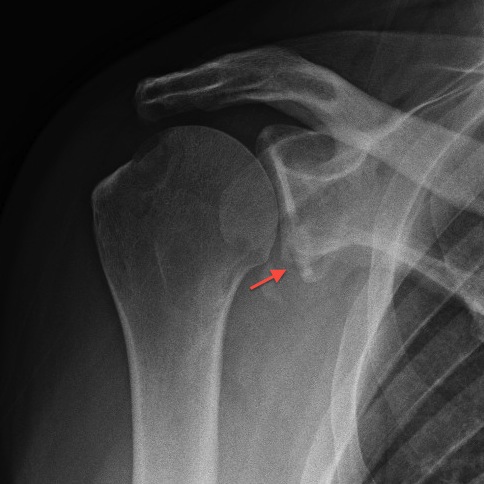Shoulder Dislocation
Why does the shoulder dislocate?
The shoulder joint has the least constraint of any major joint, meaning that it is the most mobile. This mobility is essential for activities such as throwing, swimming, and climbing. Unfortunately, this mobility also places the shoulder at risk for dislocation. In fact, the shoulder is the most commonly dislocated joint in the body.
What happens when the shoulder dislocates?
Shoulder dislocations most often result from a fall onto the affected arm, causing the humeral head (ball) to shift out of contact with the glenoid (socket). In most dislocations, the humeral head shifts anteriorly (toward the front) and often remains out of place until it is manually reduced into place.

In a normal uninjured shoulder (above left), the humeral head lies in close contact with the glenoid. When a shoulder dislocates (above right), the humeral head shifts out of contact with the glenoid resulting in injury to the surrounding tissues.

This side view of the scapula (shoulder blade) with the humerus removed shows the oval glenoid (shoulder socket) surrounded by a white ring of fibrocartilage - the labrum.

Glenoid (socket) fracture (red arrow) occasionally results from a traumatic shoulder dislocation. Read more about treatment of these so-called "bony Bankart" fractures injuries here.
The trauma associated with a shoulder dislocation leads to injury to the soft tissue and, sometimes, the bony structures of the shoulder. Damage to these structures increases an individual’s risk for additional dislocations later in life.
Soft Tissue Injury
In nearly all cases of shoulder dislocation, the anterior labrum and capsule are damaged. The labrum is the cartilage ring that attaches to the rim of the glenoid. The capsule, on the other hand, is composed of the ligaments that form the deepest connective tissue layer that surrounds the shoulder. Both the labrum and capsule are important for maintaining normal shoulder stability and function.
Bony Injury
Injury to the bone may occur on either the humeral or glenoid side of the joint. Such bony injuries further destabilize the joint, leading to additional risk of recurrent dislocation. This X-ray (below right) shows an example of a glenoid fracture resulting from a traumatic shoulder dislocation.
What is the initial treatment for shoulder dislocation?
Initial treatment for shoulder dislocation involves rest, use of a sling, and gradual return to activity as pain diminishes and strength returns with the aid of physical therapy.
Is my shoulder going to dislocate again?
Risk of recurrent dislocation depends on a variety of factors including age, participation in contact sports, and extent of bony injury. Age appears to be one of the most important risk factors. Recent studies suggest that individuals in their teens and early 20’s are at greatest risk for recurrent dislocation, with recurrence rates of over 50%.
What is the role of surgery for shoulder dislocation?
Surgery to repair the injured labrum and capsule (and to address bony injuries, if present) may be needed to restore stability to the joint. Surgery is more often recommended for young people, those with multiple dislocations, and those with associated bony injury. These are the people at greatest risk of recurrent dislocation.
In most cases, surgery involves arthroscopic repair of the injured labrum and capsule. This is known as an arthroscopic Bankart repair. For individuals with bony injury, Dr. Driscoll may also recommend procedures such as arthroscopic bony Bankart repair, arthroscopic Remplissage, or Latarjet.
